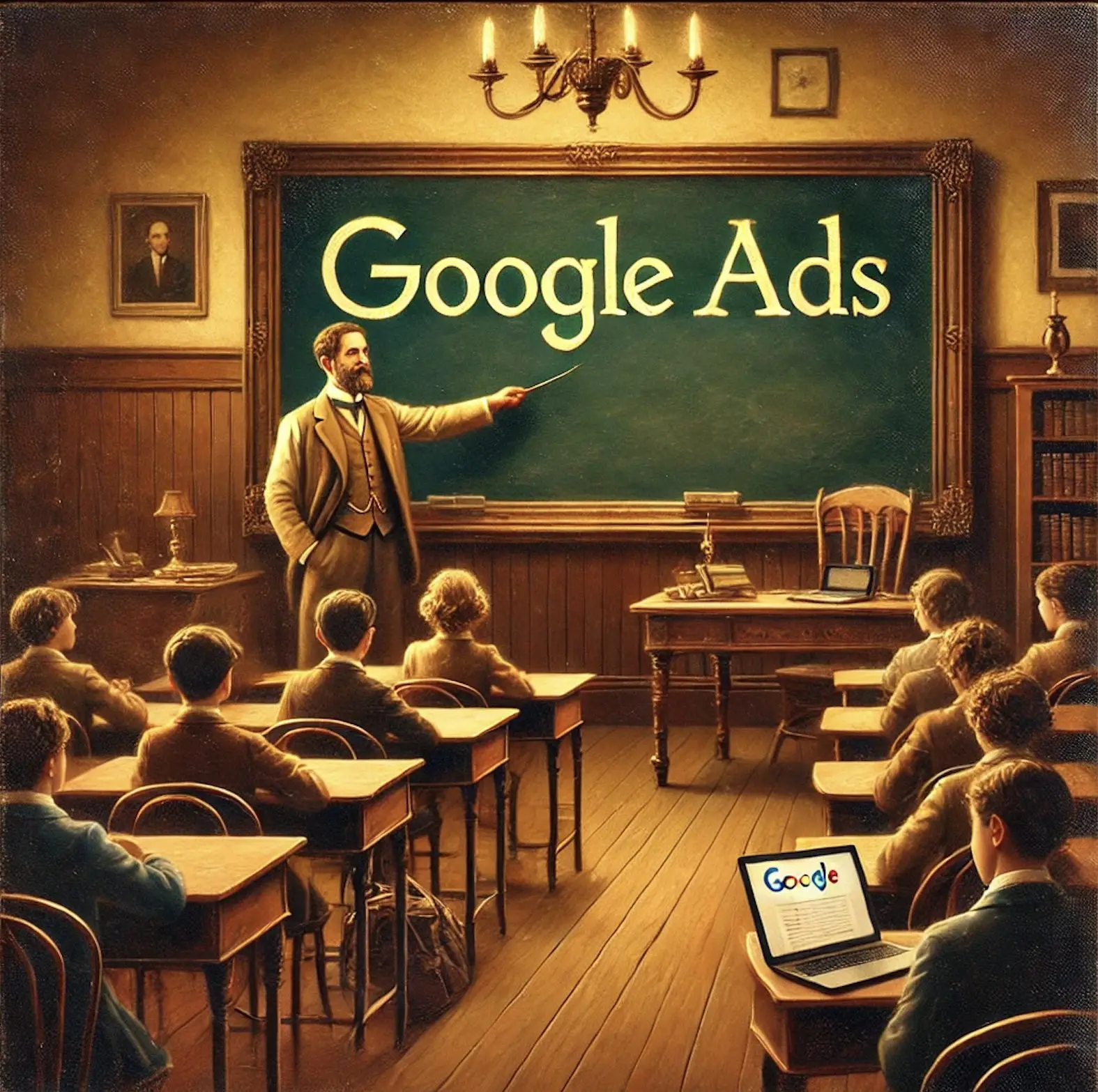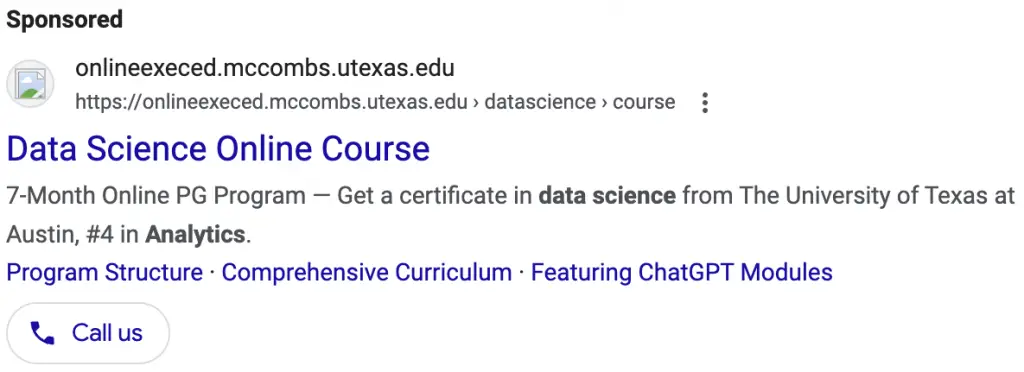
Targeting the Right Demographics with Google Ads for Schools
Understanding and targeting the right demographic is crucial for schools using Google Ads to achieve enrollment and financial goals.
Unlike other businesses, schools must focus on highly specific audience segments to ensure their campaigns resonate with the right people.
Here’s how schools can excel in demographic targeting:
Identify Parent Profiles
- Schools primarily appeal to parents or guardians, making it essential to segment campaigns based on their characteristics:
- Age Range: Focus on adults aged 25-45, as this group typically includes parents of school-aged children. For high schools, expand the range slightly to include older guardians.
- Parental Interests: Use affinity audiences to target parents interested in topics like education, child development, or extracurricular activities.
- Household Income: Many parents prioritize educational quality within their financial means. Use income targeting to align your messaging with families likely to afford your school’s tuition or programs.
Geographic Precision
Unlike other industries, schools cater to specific localities. Use geo-targeting to focus on:
- Catchment Areas: Identify neighborhoods or towns where most of your current students live and concentrate your ads there.
- Commuting Distance: Target areas within a realistic commuting radius of your school.
- Local Events: Create localized campaigns around open houses, parent-teacher conferences, or other school events.
Tailor Campaigns by Education Stage
Different types of schools serve distinct age groups, requiring tailored approaches:
- Preschools and Elementary Schools: Highlight nurturing environments, early education programs, and child safety to appeal to young families.
- High Schools: Focus on academic achievements, extracurricular opportunities, and college preparation to attract parents of teens.
- Specialized Programs: If your school offers unique curriculums like STEM, arts, or bilingual programs, ensure these are prominent in ads targeting families with relevant interests.
Crafting an Effective Campaign and Ad Group Structure for Schools
The structure of your Google Ads campaign plays a pivotal role in driving enrollment and boosting profits for schools.
A well-organized campaign ensures your ads are targeted, relevant, and cost-effective.
For schools, where messaging needs to resonate with specific audiences, a strategic campaign and ad group structure is essential.
Here’s how to build one tailored for educational institutions:
Organize Campaigns by School Objectives
Start by defining your school’s key objectives and structuring campaigns around them. For example:
- Enrollment Campaigns: Focus on attracting new students with ads promoting open houses, application deadlines, or specific programs.
- Event Campaigns: Dedicate campaigns to events like campus tours, summer programs, or informational webinars.
- Brand Awareness Campaigns: Showcase your school’s achievements, values, and unique features to build long-term visibility.
Each campaign should have a clear purpose and its own budget, ensuring funds are allocated where they’re most needed.
Break Down Ad Groups by Audience Segments
Within each campaign, create ad groups that align with specific audience segments or themes. For schools, this might include:
- Educational Stages: Separate ad groups for preschool, elementary, middle school, and high school. This allows you to craft ads and keywords specific to each stage of education.
- Special Programs: If your school offers programs like arts, STEM, or bilingual education, dedicate ad groups to each. Tailor the keywords and ad copy to highlight these unique offerings.
- Geographic Targeting: If your school serves multiple neighborhoods or regions, create ad groups for each area. Include location-specific keywords like “best elementary school in [city].”
Use Granular Keyword Targeting
Keep keywords tightly aligned within each ad group to improve relevance and Quality Scores. For example:
- Ad Group for Preschool: Include keywords like “preschool near me,” “early childhood education,” and “daycare with curriculum.”
- Ad Group for High School: Use keywords such as “college preparatory high school,” “top high schools,” and “high school scholarships.”
- Avoid mixing unrelated keywords within a single ad group, as this can dilute your ad relevance.
Choosing the Best Ad Types and Formats for Schools
Selecting the right ad types and formats is crucial for schools aiming to maximize enrollment and generate revenue with Google Ads.
Each format offers unique opportunities to connect with potential families, showcase your school’s strengths, and drive action.
Here’s how schools can leverage specific ad types effectively:
Search Ads: Direct Answers for Parent Queries
Search ads are ideal for capturing parents actively looking for educational options. These ads should be structured to address specific search intent:
- Branded Search Ads: Target queries that include your school’s name, ensuring you control the narrative and guide searchers to the right pages.
- Program-Specific Ads: Tailor ads for unique offerings like STEM programs, bilingual education, or arts curricula. For example, an ad headline might read: “Enroll in Our Top-Ranked STEM Program Today.”
- Location-Based Ads: Use location-specific keywords such as “private schools near [city]” or “top high schools in [area]” to appear in local search results.

Display Ads: Building Awareness in Your Community
Display ads are an effective way to increase visibility among parents who might not yet be actively searching for a school. They work well for:
- Promoting Open Houses: Use eye-catching visuals with dates and details for upcoming events.
- Highlighting Achievements: Showcase awards, accreditations, or high graduation rates to build trust and credibility.
- Geographic Targeting: Focus on neighborhoods or regions within your school’s catchment area.
To make your display ads compelling:
- Include professional images of your school, such as classrooms, happy students, or modern facilities.
- Use concise, impactful messaging paired with a strong call-to-action like “Learn More” or “Visit Us Today.”

Video Ads: Showcasing the School Experience
Video ads, especially on YouTube, are a powerful way to give parents a virtual tour of your school. This format allows for storytelling and emotional engagement:
- Virtual Campus Tours: Showcase classrooms, extracurricular spaces, and community areas to give prospective families a feel for the environment.
- Testimonials: Feature short clips of students, alumni, or parents sharing their positive experiences.
- Day-in-the-Life Videos: Highlight a typical school day, including classes, activities, and interactions between students and teachers.
YouTube’s targeting options let you reach parents based on interests, demographics, or even specific videos they’ve watched, such as parenting or education-related content.
Video testimonials are a must-have for schools looking to boost conversion rates and reduce their marketing cost per enrollment.
Who doesn’t want to study at Cambridge University after watching this video?
Remarketing Ads: Staying Top of Mind
Remarketing ads ensure your school remains visible to parents who have visited your website but didn’t take action. Use this format to:
- Re-engage visitors with reminders about application deadlines or upcoming events.
- Highlight testimonials or unique programs to reinforce why your school is the best choice.
- Offer promotions for early applications or tuition discounts for first-time enrollments.
Defining and Targeting the Right Audience for Schools
When it comes to running successful Google Ads campaigns for schools, identifying and targeting the right audience is critical.
The education industry requires precision in reaching parents, guardians, and even students who fit the profile of your ideal enrollees.
Tailoring your audience settings can significantly impact enrollment rates and your return on investment.
Here’s how to approach audience targeting specifically for schools:
Focus on Parents and Guardians
Schools primarily need to reach parents or guardians making decisions about their child’s education. Effective audience segmentation includes:
- Parental Interests and Affinity Groups: Target parents interested in education, parenting resources, or child development. Use Google’s predefined affinity audiences, such as “Parents of Preschoolers” or “Parents of Teens,” to refine your reach.
- Life Events Targeting: Take advantage of Google’s “Life Events” targeting, which allows you to reach parents who are recently moving, expecting a child, or planning for school transitions like preschool to elementary or middle school to high school.
- Household Dynamics: If your school offers scholarships, financial aid, or tiered tuition rates, consider targeting by household income levels to ensure ads resonate with families in different economic brackets.
Target Students When Applicable
For high schools or specialized programs (e.g., summer camps, music academies), targeting students directly can also be beneficial:
- Use YouTube or Google Display Network to target teens interested in specific activities, such as athletics, arts, or advanced placement courses.
- Include messaging that appeals to student aspirations, such as college preparation or career-focused learning paths.
Geographic Targeting for Schools
Geography plays an outsized role in defining the audience for schools. Parents typically look for educational institutions close to home or within a manageable commute. To optimize geographic targeting:
- Radius Targeting: Set a radius around your school’s location, focusing on areas where most of your current students reside.
- ZIP Code Segmentation: For schools with distinct catchment areas, create campaigns tailored to ZIP codes where potential families are located. Ads can include localized messaging, such as “Top-rated private school in [Neighborhood].”
- Regional Events: If you’re promoting events like open houses, use geo-targeting to ensure families within a specific distance see the ads.
Build Custom Audiences Based on Behavior
Custom audiences let you target users based on their online behavior and search habits. For schools, this might include:
- Users searching for terms like “private schools near me,” “affordable tuition,” or “after-school programs.”
- Families researching alternative education options, such as Montessori or charter schools.
- Parents frequently visiting parenting blogs, education sites, or local community forums.
Layered Targeting for Precision
For maximum impact, combine targeting options to refine your audience. For instance:
- Use geo-targeting within a specific radius while focusing on “Parents of Preschoolers” or “Parents of Teens.”
- Layer demographic data (such as income levels) with interests like “Education Enthusiasts” to reach families aligned with your school’s offerings.
Crafting the Perfect Keyword Strategy for Schools
Selecting the right keywords is a cornerstone of running successful Google Ads campaigns for schools.
For educational institutions, keyword strategy goes beyond generic terms, focusing on highly specific phrases that resonate with prospective families and align with their search intent.
Here’s how schools can develop a targeted and effective keyword strategy:
Prioritize Intent-Based Keywords
Parents and guardians searching for schools often use keywords that reflect their specific needs or concerns. Understanding this intent allows you to select high-converting keywords such as:
- Informational Keywords: These appeal to families gathering initial information, like “top schools near me,” “best private schools in [location],” or “high school rankings in [city].”
- Transactional Keywords: These signal readiness to act, such as “apply to [school name],” “enroll in preschool near me,” or “schedule a campus tour.”
- Problem-Solving Keywords: Target searches addressing concerns, such as “affordable private schools,” “schools with financial aid,” or “special needs programs in [location].”
Include Location-Specific Keywords
For schools, geographic targeting is critical. Parents often include location terms in their searches, making geo-specific keywords highly effective:
- Incorporate city, neighborhood, or district names into your keywords: “elementary schools in [neighborhood]” or “private high schools near [city].”
- Use variations like “best,” “top-rated,” or “award-winning” combined with location: “best charter schools in [area].”
- Highlight transportation options for broader reach: “schools with bus service near [city].”
Highlight Unique Offerings
Every school has distinguishing features that attract families. Build keyword groups around these unique selling points:
- Program-Specific Keywords: If your school offers specialized curriculums, target terms like “STEM schools near me,” “arts-focused education,” or “bilingual elementary programs.”
- Extracurricular Activities: Promote unique offerings with keywords like “schools with robotics clubs,” “schools with strong athletics programs,” or “music-focused high schools.”
- Values and Approach: Include terms that reflect your educational philosophy, such as “Montessori schools near me,” “Christian schools in [city],” or “project-based learning schools.”
Leverage Long-Tail Keywords
Long-tail keywords may have lower search volumes, but they often attract highly motivated families:
- “What is the best private preschool near [location]?”
- “Schools with scholarships for low-income families in [city].”
- “High schools with AP courses and college counseling in [region].”
These terms can also reduce competition and cost-per-click while increasing the likelihood of conversions.
Address Common Parent Concerns
Families often search for solutions to specific educational challenges. Use keywords that address these concerns:
- “Schools with small class sizes near me.”
- “Safe schools in [city] for elementary kids.”
- “Schools with excellent teacher-to-student ratios.”
Exclude Irrelevant Traffic with Negative Keywords
Negative keywords prevent your ads from showing for unrelated searches, saving your budget for the most relevant audiences. For schools, this might include:
- “Free schools” if you’re a tuition-based institution.
- “Online schools” if you only offer in-person education.
- “Colleges” or “universities” if you target K-12 education.
Crafting Compelling Ad Content for Schools
The success of Google Ads for schools often hinges on the quality and relevance of the ad content.
From the text to visuals, every element of the ad should speak directly to parents and students, addressing their needs, concerns, and aspirations.
Here’s how schools can create high-performing ad content that drives enrollment and builds trust.
Ad Copy: Clear, Persuasive, and Parent-Focused
The written content of your ads must be concise and tailored to the unique concerns of families evaluating schools. Focus on these principles:
Highlight Your School’s Unique Strengths: Showcase what sets your school apart, such as academic achievements, extracurricular programs, or safety measures.
- Example: “Award-Winning STEM Programs for Grades 6–12. Enroll Today!”
- Example: “Small Class Sizes, Big Opportunities. Schedule a Tour Now!”
Use Action-Oriented Language: Encourage immediate engagement with clear calls-to-action (CTAs) like:
- “Book a Free Campus Tour.”
- “Apply Now for Fall Enrollment.”
- “Discover Our Scholarship Opportunities.”
Address Parental Concerns: Tailor your messaging to reassure parents about common priorities:
- Safety: “Safe and Secure Learning Environment for Every Child.”
- Preparation: “Top High School for College Readiness in [City].”
- Accessibility: “Affordable Private Education with Flexible Payment Plans.”
Incorporate Emotional Appeal: Education is an emotional decision for parents. Use language that reflects values and aspirations:
- “Helping Your Child Thrive Academically and Personally.”
- “Where Future Leaders Begin Their Journey.”
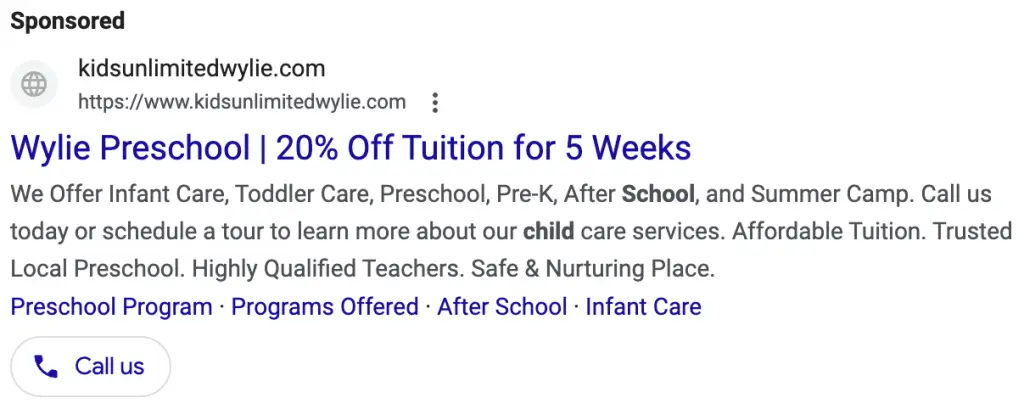
Images: Engaging and Representative of School Life
Images play a vital role in connecting with your audience visually. For schools, the right images can evoke trust, aspiration, and a sense of belonging. Prioritize:
Authenticity: Use photos of real students, teachers, and facilities to build credibility. Avoid generic stock photos that might seem impersonal.
Showcase Diversity: Include images that reflect the diversity of your student body to help prospective families see themselves in your school.
Highlight Key Moments: Capture moments that showcase your school’s culture and strengths, such as:
- Students actively participating in class.
- Sports teams or music groups performing.
- Smiling children on a playground or in creative workshops.
Include Facilities: Display clean, inviting classrooms, libraries, or recreational spaces to reassure parents about the quality of your school’s environment.
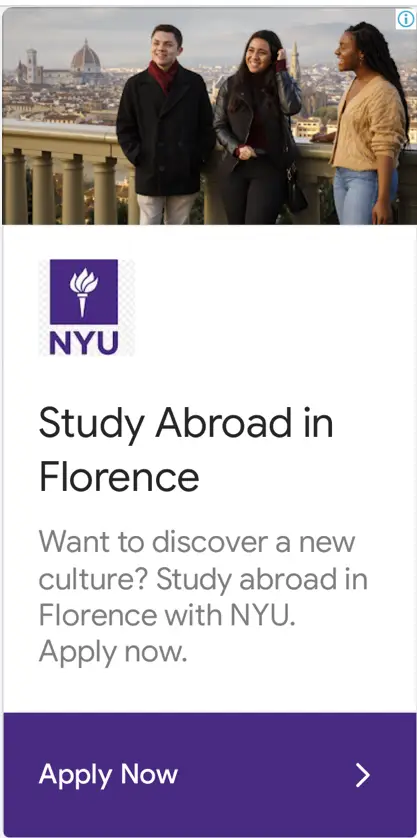
NYU promotes its Florence program with an inspiring image featuring the city and happy students from the program
Videos: A Powerful Tool for Storytelling
Videos offer a dynamic way to engage parents and students by giving them a glimpse into the school experience. Schools can leverage video content in ads for maximum impact:
Virtual Campus Tours: Show off your school’s campus, including classrooms, sports facilities, and common areas, to make a strong first impression.
Day-in-the-Life Videos: Highlight a typical day at your school to give prospective families an idea of the student experience.
Testimonials: Feature short, heartfelt testimonials from current students, parents, and alumni to build trust and demonstrate your school’s impact.
Event Highlights: Promote past events like open houses, graduation ceremonies, or school fairs to showcase your vibrant community.
Using Ad Extensions to Maximize Impact for Schools
Ad extensions are a powerful tool for schools to enhance their Google Ads campaigns, providing additional information and opportunities for parents to engage.
By leveraging ad extensions strategically, schools can make their ads more appealing, relevant, and actionable. Here’s how schools can use ad extensions effectively to boost enrollment and profits:
Sitelink Extensions: Direct Access to Key Pages
Sitelink extensions allow schools to link directly to multiple relevant pages on their website, offering parents quick access to the information they value most. For schools, this could include:
- Admissions Information: Link to pages detailing the application process, tuition, and deadlines.
- Program Highlights: Direct parents to specialized program pages, such as STEM, arts, or bilingual education.
- Campus Tour Scheduling: Provide a direct link for parents to book in-person or virtual tours.
- Contact Us: Make it easy for parents to find the school’s contact details or inquiry forms.
Example:
- Ad Headline: “Top-Rated Private School in [City]”
- Sitelinks:
- “Admissions Process”
- “STEM & Arts Programs”
- “Schedule a Tour”
- “Tuition & Scholarships”
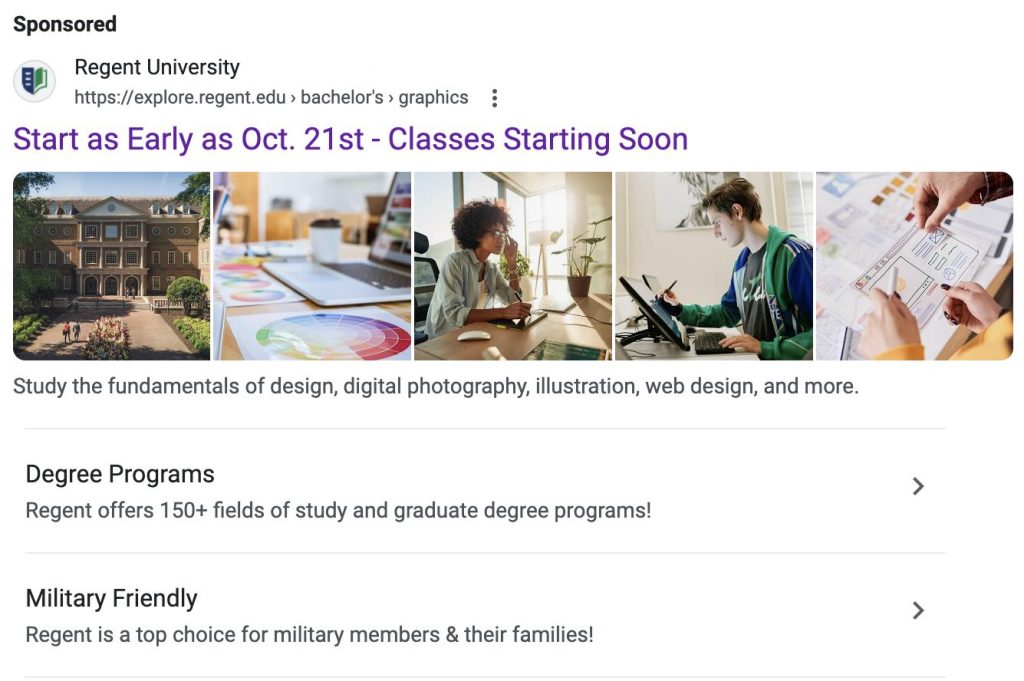
Call Extensions: Immediate Contact for Admissions
Call extensions add a phone number directly to your ad, allowing parents to contact the admissions office with a single click. This is especially useful for:
- Parents who prefer speaking to someone directly about the application process or school policies.
- Highlighting specific hours when your admissions office is available to handle inquiries.
Example:
- Ad: “Enroll at [School Name] Today – Learn More About Our Award-Winning Programs”
- Call Extension: “Call Us: [Phone Number] (Mon-Fri, 9 AM – 5 PM)”

Location Extensions: Build Trust with Local Presence
Schools serving specific regions can use location extensions to show their address, helping parents verify proximity and locate the campus easily. For schools, location extensions can:
- Highlight the convenience of your location for nearby families.
- Encourage in-person visits for tours or open houses.
- Integrate with Google Maps to provide directions.
Example:
- Ad: “Visit [School Name] in [Neighborhood]”
- Location Extension: “[Address] – Directions Available on Google Maps”
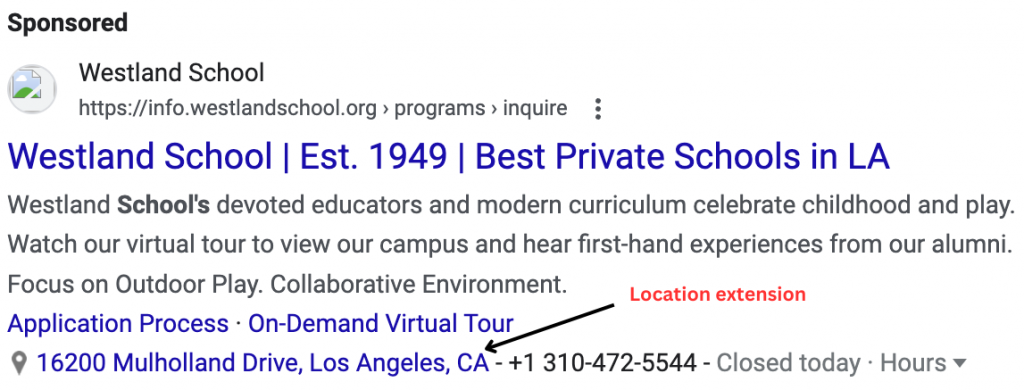
Callout Extensions: Showcase Unique Features
Callout extensions let schools emphasize their unique selling points in a concise format. Use these to highlight benefits that set your institution apart:
- “Small Class Sizes”
- “Award-Winning STEM Programs”
- “Scholarship Opportunities Available”
- “Safe and Inclusive Environment”
Example:
- Ad: “Empowering Future Leaders at [School Name]”
- Callouts: “College Prep Focused” | “Extracurricular Excellence” | “Affordable Tuition Plans”
Structured Snippet Extensions: Highlight Key Offerings
Structured snippets allow schools to categorize their programs, activities, or unique features into predefined headers. Ideal headers for schools include:
- Programs: “STEM, Arts, Athletics, Music”
- Grades: “Preschool, Elementary, Middle School, High School”
- Special Offerings: “Scholarships, Bilingual Programs, AP Courses”
Example:
- Ad: “Discover Excellence at [School Name]”
- Structured Snippet: “Programs: STEM, Arts, Athletics, AP Courses”
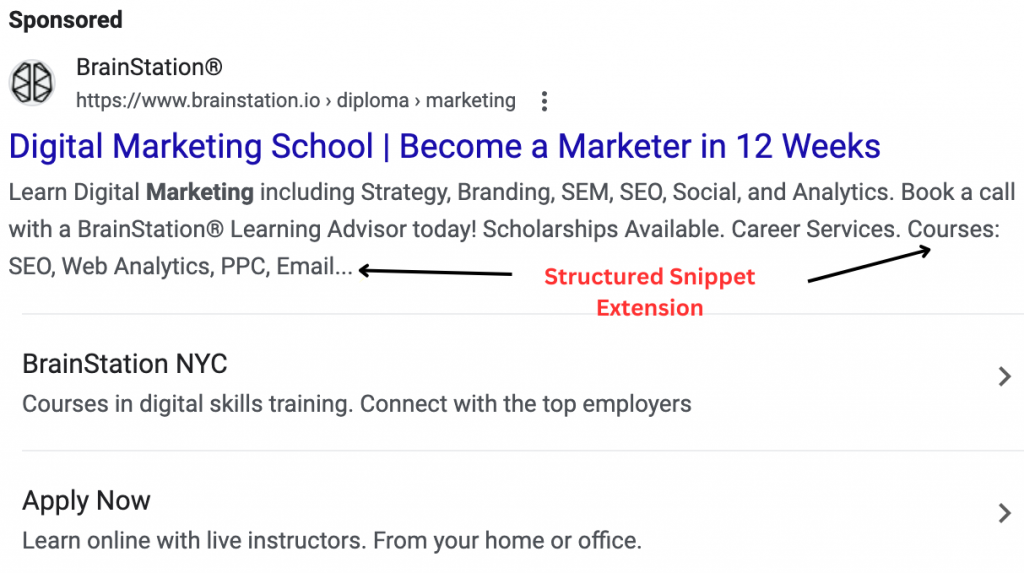
Price Extensions: Promote Transparent Costs
For private or charter schools, price extensions can highlight tuition rates, fees, or program costs. This builds transparency and helps parents quickly assess affordability. You can also showcase value by linking costs to specific programs or grade levels.
Example:
- Ad: “Top Private School in [City] – Enroll Today”
- Price Extension: “Preschool: $5,000/Year | Elementary: $7,000/Year | High School: $9,000/Year”
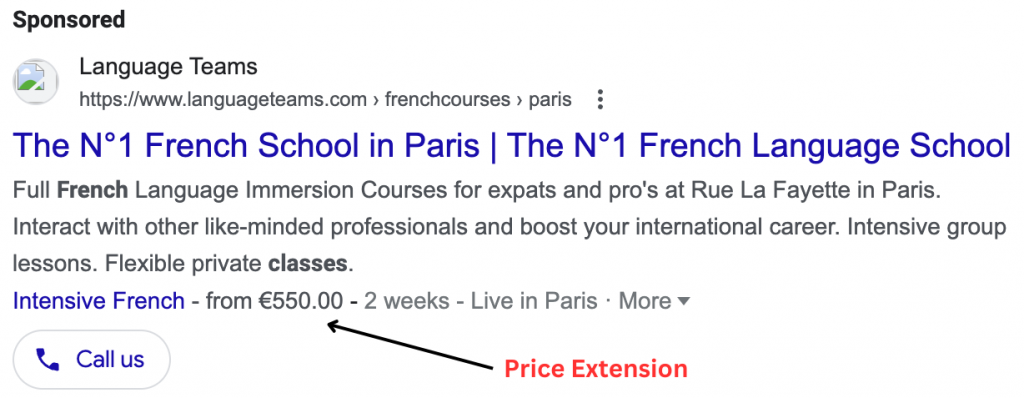
Event Extensions: Promote Open Houses and Deadlines
Schools frequently host events such as open houses or information sessions. Use event extensions to advertise these dates prominently within your ads:
- “Open House: January 15, 10 AM – 2 PM”
- “Application Deadline: February 1”
Designing High-Performing Landing Pages for Schools
A well-crafted landing page is critical for converting clicks from Google Ads into inquiries and enrollments for schools.
Unlike generic web pages, landing pages are highly targeted, offering specific information and clear calls-to-action tailored to prospective families. For schools, these pages should address parent concerns, highlight key benefits, and make it easy to take the next step.
Here’s how to create landing pages that drive results.
Match Landing Pages to Ad Campaigns
Each Google Ads campaign should direct users to a landing page that aligns perfectly with the ad’s messaging and intent. For example:
- Open House Campaign: Create a dedicated page with event details, registration forms, and compelling reasons to attend.
- Program-Specific Ads: Link to pages focusing on specific offerings like STEM, arts, or bilingual education, complete with program highlights and success stories.
- Enrollment Campaign: Feature a page with straightforward application instructions, deadlines, and a form to request more information.
Consistency between the ad copy and the landing page reassures visitors that they’re in the right place, improving engagement and conversion rates.
Highlight Unique Selling Points (USPs)
Your landing page should immediately communicate what sets your school apart. Use bold headlines, subheadings, and visuals to showcase:
- Academic achievements, such as high test scores, awards, or college placement rates.
- Extracurricular excellence in sports, arts, or clubs.
- Facilities like modern science labs, libraries, or performance spaces.
- Values or philosophies, such as project-based learning, inclusivity, or a faith-based curriculum.
Example:
- Headline: “Empowering Students Through Innovation and Excellence”
- Subheading: “Top-ranked STEM and Arts programs for grades 6–12 in [City]”
Use Visuals to Engage and Build Trust
Images and videos play a significant role in building trust with prospective families. For school-specific landing pages:
- Include high-quality photos of classrooms, activities, and smiling students to convey a welcoming atmosphere.
- Use testimonial videos from parents, students, or alumni to add authenticity.
- Incorporate virtual tours or aerial shots of the campus to offer an immersive experience.
Provide Clear and Actionable CTAs
A strong call-to-action (CTA) is essential to guide visitors toward the desired action. For schools, CTAs should be specific, actionable, and easy to locate. Examples include:
- “Schedule a Tour Today”
- “Apply Now for the 2025 Academic Year”
- “Request More Information”
Place CTAs above the fold, as well as at logical points further down the page, ensuring they’re always accessible without overwhelming the user.
Simplify Forms for Better Conversions
Most school landing pages will feature forms for inquiries, tour scheduling, or applications. To maximize form submissions:
- Keep forms short, requesting only essential information like name, email, and the student’s grade level.
- Use dropdowns or checkboxes to make fields easier to fill out.
- Include a clear submission button with language like “Submit Inquiry” or “Reserve Your Spot.”
Optimize for Mobile and Speed
Many parents will access your landing page on their phones. Ensure your page is mobile-friendly by:
- Using responsive design so images and text display correctly on smaller screens.
- Keeping loading times under three seconds to avoid losing visitors.
- Simplifying navigation and ensuring forms are easy to complete on mobile devices.
Include Social Proof and Trust Signals
Parents need assurance that your school is the right choice. Build trust with:
- Testimonials: Highlight quotes from satisfied parents, students, or alumni.
- Awards and Accreditations: Display badges or logos from accrediting bodies or education awards.
- Stats and Figures: Share impressive metrics like graduation rates, college acceptances, or teacher-to-student ratios.
Drive Urgency Where Appropriate
Encourage action by incorporating time-sensitive elements such as:
- Countdown timers for open house registration or enrollment deadlines.
- Messaging like “Limited Spots Available for Fall 2025 – Apply Today!”
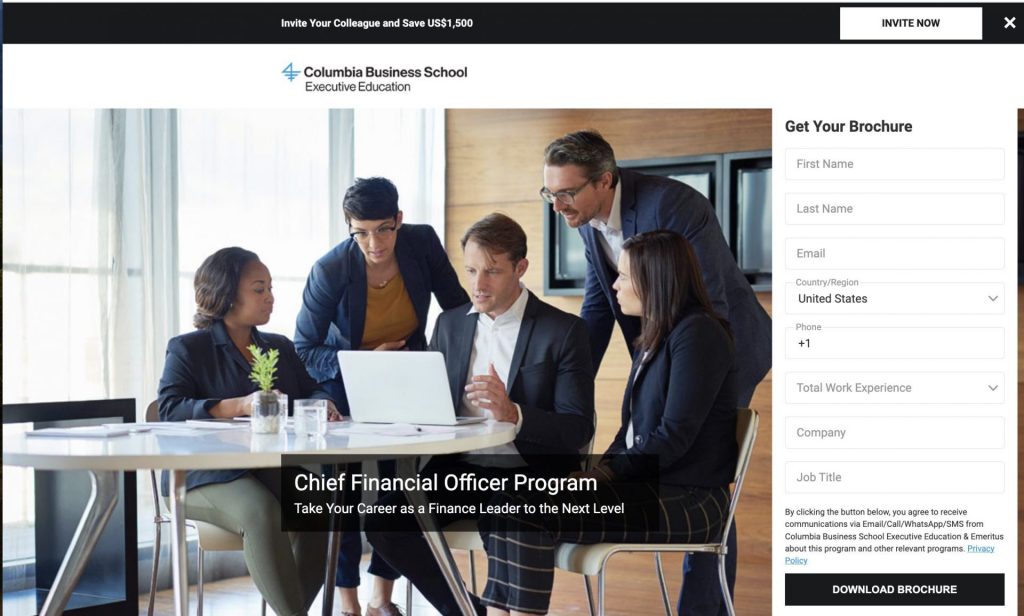
A program-specific landing page that could be enhanced with social proof for greater impact.
https://columbia-online-executive-education.emeritus.org/chief-financial-officer
Real-Life Success Stories: How Schools Used Google Ads to Boost Enrollment and Profits
Google Ads has proven to be a game-changer for schools looking to connect with prospective families and grow their student base. Let’s explore three specific examples, highlighting the strategies and actions that led to measurable success.
Sydney Grammar School (Sydney, Australia): Driving Open House Attendance
Objective: Attract more families to their annual open house event.
Google Ads Strategies:
- Geo-Targeted Display Ads: Targeted parents in affluent neighborhoods within a 30-kilometer radius of Sydney Grammar School.
- Event Extensions: Featured the event date and a direct registration link in ads.
- Custom Audiences: Used Google’s custom intent audiences to target parents actively searching for private schools, tutoring, or extracurricular programs.
Ad Example:
- Headline: “Explore Sydney Grammar School – Open House This Saturday!”
- Description: “Join us to discover how your child can thrive. RSVP today to secure your spot!”
- Event Extension: “January 20, 10 AM – 2 PM | Register Now.”
Results:
- 200% increase in open house registrations compared to the previous year.
- Generated high-quality leads with over 60% of attendees submitting post-event inquiries.
- Strengthened brand presence in competitive private school markets.
The Gow School (South Wales, New York, USA): Connecting with Families Seeking Specialized Education
Objective: Increase inquiries and enrollment for students with learning differences, such as dyslexia and ADHD.
Google Ads Strategies:
- Long-Tail Keyword Targeting: Focused on specific search terms like “schools for dyslexia in New York” and “private schools for ADHD support.”
- Dynamic Search Ads (DSAs): Automatically created ads targeting pages on the school’s website that described their unique learning programs.
- Remarketing Campaigns: Re-engaged parents who visited the website but didn’t submit an inquiry form, using display ads to highlight testimonials and success stories from alumni.
Ad Example:
- Headline: “Specialized Education for Students with Dyslexia”
- Description: “Empowering students to thrive. Learn about our tailored programs and experienced staff. Inquire today!”
- Sitelinks: “Learning Programs,” “Schedule a Tour,” “Admissions,” “Parent Testimonials.”
Results:
- 20% increase in inquiries within the first three months of the campaign.
- A significant boost in enrollment, with families citing Google Ads as a key discovery point.
- Greater visibility for The Gow School as a leader in specialized education across nearby states.
St. George’s School (Vancouver, Canada): Boosting Boarding Applications
Objective: Increase boarding student applications for the upcoming academic year.
Google Ads Strategies:
- Keyword Targeting: Focused on high-intent phrases like “top boarding schools in Canada” and “private boarding schools near Vancouver.”
- International Reach: Used location-based targeting to advertise in countries with high interest in Canadian boarding schools, including China and India, alongside domestic audiences.
- Responsive Search Ads: Created multiple ad variations emphasizing academic excellence, extracurricular programs, and state-of-the-art boarding facilities.
Ad Example:
- Headline: “Top-Ranked Boarding School in Canada”
- Description: “Experience world-class education at St. George’s. Limited spots available – apply now!”
- Sitelinks: “Campus Tour,” “Scholarships,” “Academic Programs,” “Boarding Life.”
Results:
- 45% increase in applications from international students.
- Expanded reach to families across 10+ countries with highly relevant ads.
- Enhanced visibility for the boarding program, leading to a 20% boost in inquiries.
